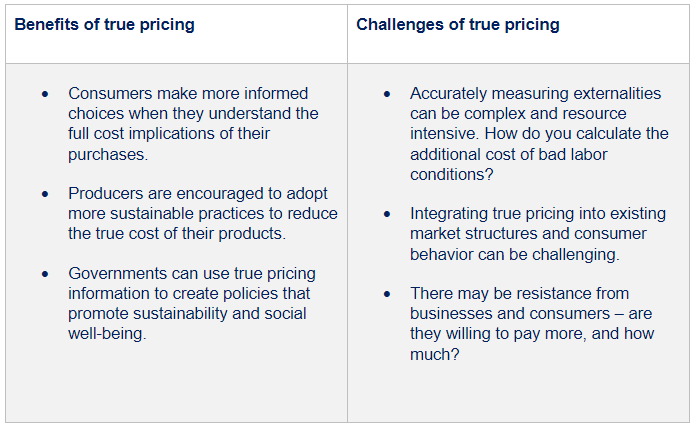
Article
Marketing with integrity: true pricing explained
Imagine walking into a store and knowing the true cost of every product on the shelf – not just the price tag, but also the environmental, social, and hidden economic costs (embedded within). True pricing aims to unveil these layers, to show consumers the real impact of their purchases. Can true pricing change the behavior of buyers? Is it a passing trend or here to stay? Let’s find out.
What is true pricing?
Does the price you pay for a pair of jeans, a T-shirt or a chocolate bar truly reflect actual production cost? The answer is a resounding NO. External factors, like environmental impact or social effects, are seldomly accounted for in the market price.
Let’s look at the store price of a T-shirt: you have some fixed costs, some variable costs, your margin, and an eventual price tag. But are you factoring in the cost of water pollution? Color dying? Workers who might be underpaid? CO2 pollution? Transport costs? Presumably not. Not just because the price of your shirt could skyrocket, but also because some of these factors are difficult or nearly impossible to measure.
Market price vs. true price
Market price: the actual price consumers pay in the market.
True price = market price
+ Environmental costs: (These include) costs related to resource depletion, pollution, carbon emissions, and other environmental impacts associated with the production, use, and disposal of the product.
+ Social costs: (These involve) labor conditions, community impacts, health effects, and other social implications of the production and consumption processes.
+ Economic costs: (This includes) both direct and indirect economic impacts, such as subsidies, taxes, and long-term economic sustainability.
This price aims to reflect the full societal cost of a product or service.
Need help with true pricing for your business? Get in touch with our experts.
Benefits & challenges
‘True pricing’ is challenging but may well be worth it. Let’s look at some of the benefits and challenges most companies face when exploring it.

On top of that, true pricing can raise a lot of questions about both your product or service and the industry in which you’re active:
- How would you go about ‘true pricing’ sustainable products like solar panels? After all, they would also get more expensive.
- Let’s say consumers aren’t willing to pay the ‘true price’ premium: is it ok to only charge parts of this premium? Does your business need to explore ‘versioning’, which is offering a true priced alternative on top of your regular offering?
- Applying true pricing means increasing the price. That might result in customers turning their backs on your business. How do you reduce churn?
- How do we get different businesses or industries as a whole on board with true pricing?
At The House of Marketing, we help you answer these questions and set up a solid true pricing model for your product or service.
A sweet example of true pricing: Tony’s Chocolonely
Some companies have taken up the challenge to set the true pricing revolution in motion. Chocolate company Tony’s Chocolonely is one of them. To determine the price of their chocolate bars, Tony’s Chocolonely ensures that:
- cocoa farmers are paid a living income, which is higher than the market price.
- environmental costs like carbon emissions associated with cocoa production, and activation, and deforestation are factored in the price.
- social costs are included as well, for combatting child labor and ensuring safe working conditions for farmers.
That’s why a Tony’s Chocolonely bar is generally more expensive than a regular chocolate bar. Tony’s Chocolonely is fully transparent about how it calculates its costs. In their True Price Report, they show consumers how their money is used to support fair trade and sustainability efforts.
Our approach for your first steps in true pricing
All set to experiment with true pricing but keen for some help? Our experts get the ball rolling in 3 steps:
Step #1: Determine your positioning
Starts with positioning: what kind of company do you want to be? Is your goal to be a gamechanger in true pricing like Tony’s Chocolonely? In that case, the key will be to translate your positioning well towards the consumer. Marketing plays a big/major role here.
Step #2: Scan your value chain for negative effects and determine indicators
From environmental impact to worker intimidation: these can be indicators of negative effects in your value chain. We help you with the necessary calculations to define the true price of your product or service.
Step #3: Implement your new price strategy
Are you pushing true pricing on all your products or services? At what speed do you want to roll out your new strategy? We help you answer these, and many more questions, to ensure a successful implementation of true pricing for your company.
How to make true pricing a success story
To conclude: true pricing is a great concept on the road towards a more sustainable approach for your company … but it’s challenging to apply. In the end, it will be up to the consumers to decide whether or not they want to shell out more money for a more sustainable product or service. After all, some products become significantly more expensive if you would charge their ‘true price’. Diapers or airline tickets become 60% more expensive, for example. Whether true pricing is a strategy worth exploring, will depend on your company’s product or service.
At The House of Marketing we help businesses with extensive studies and market research on pricing, willingness to pay, sustainability, and other factors of true pricing.
Eager to explore the possibilities of true pricing?
